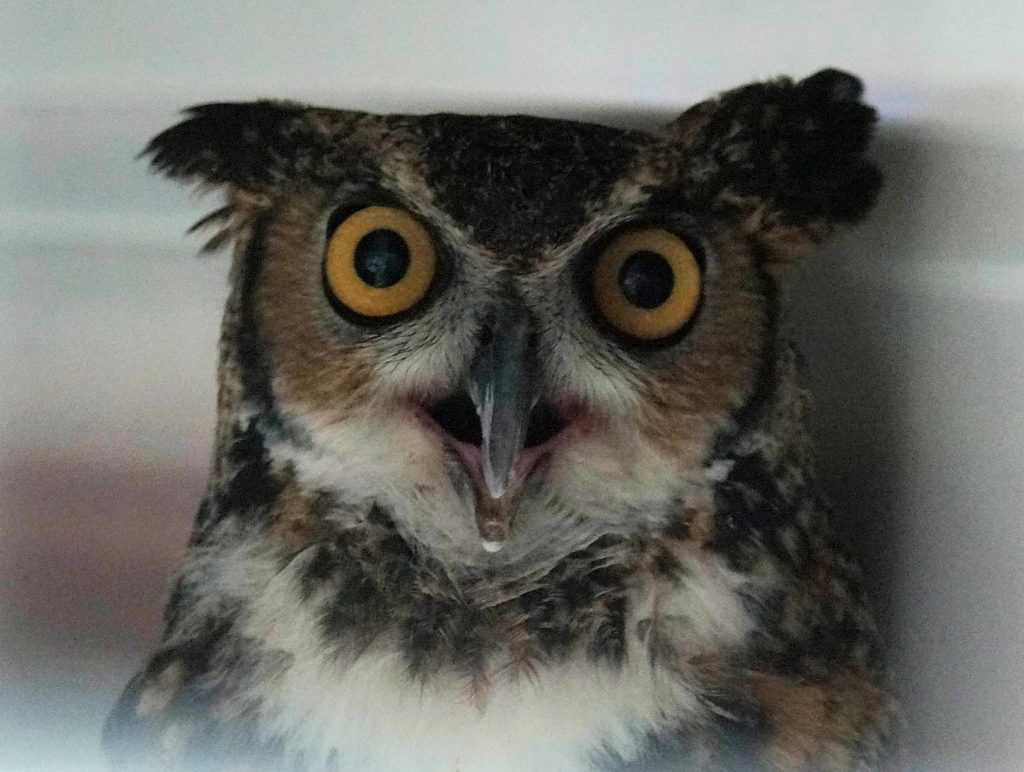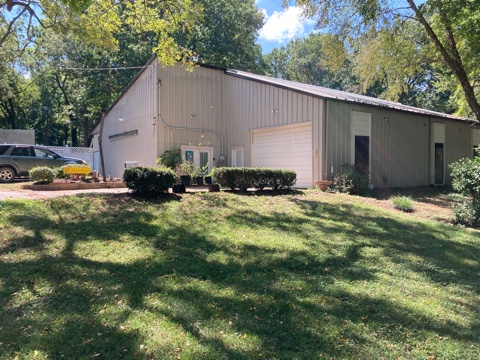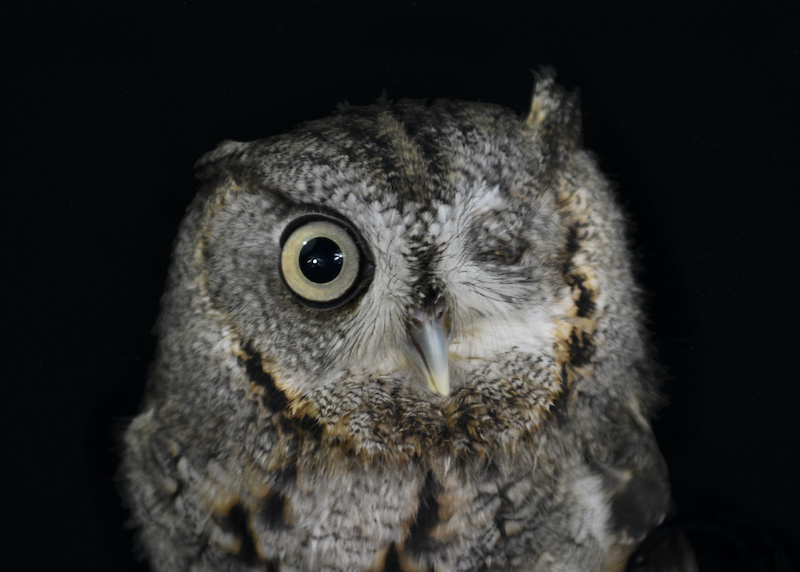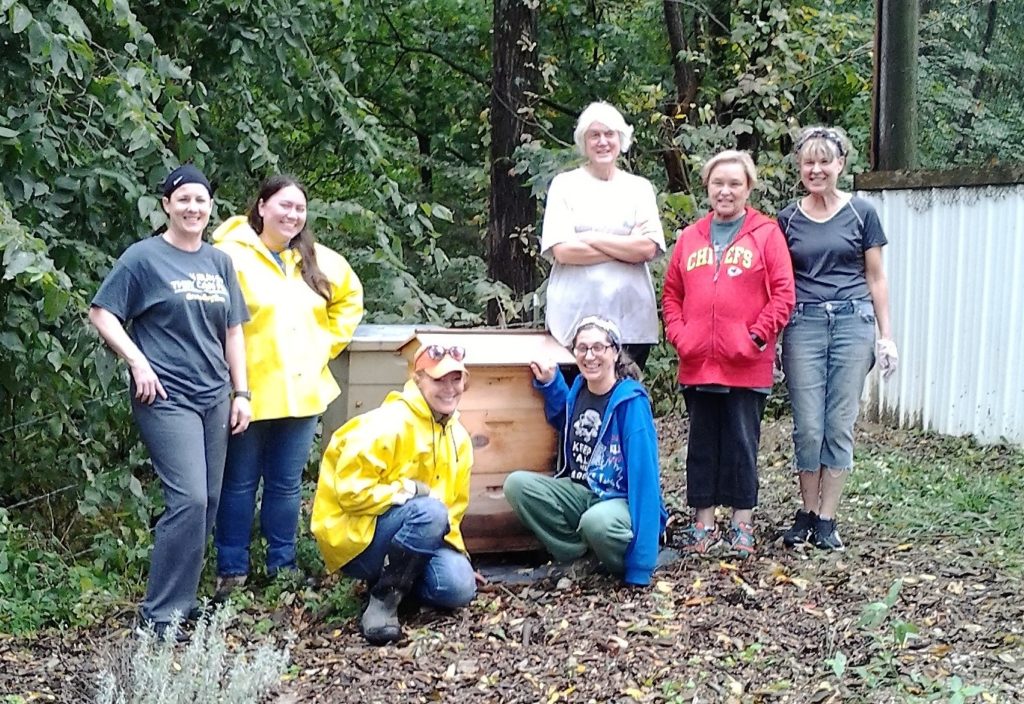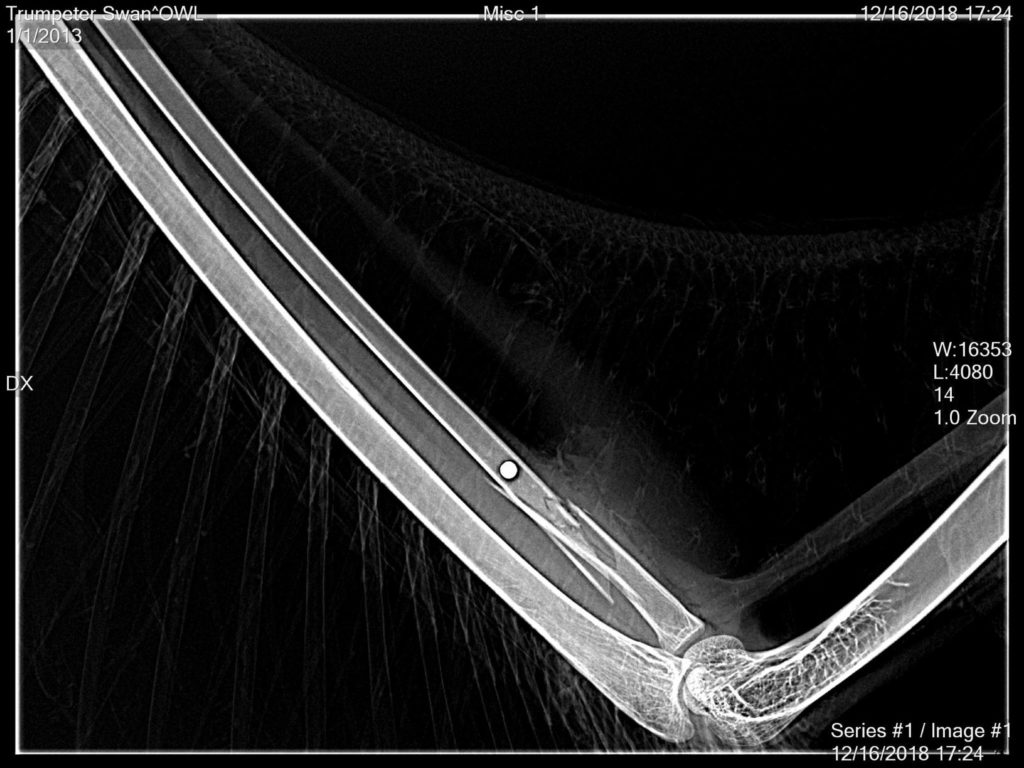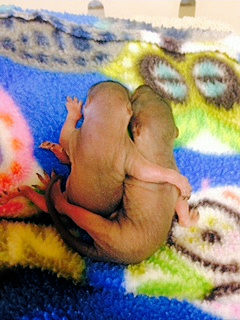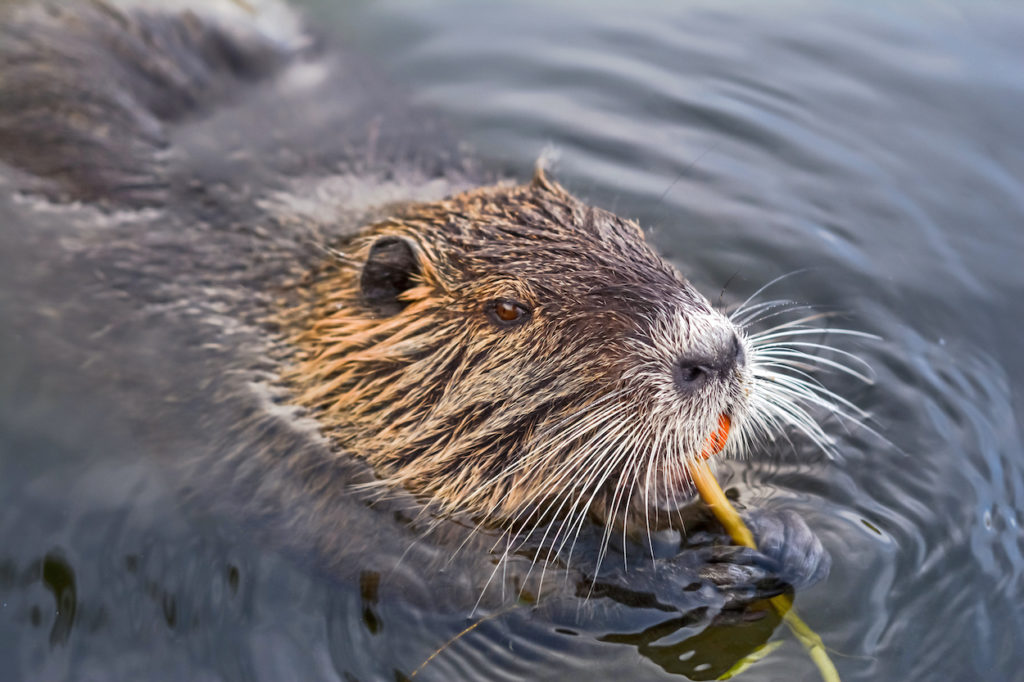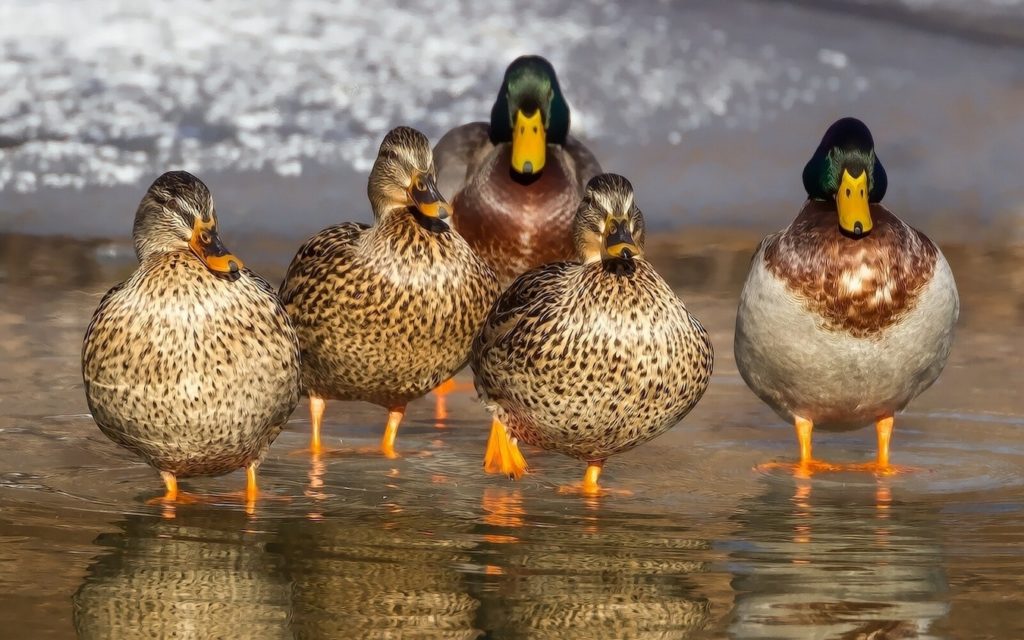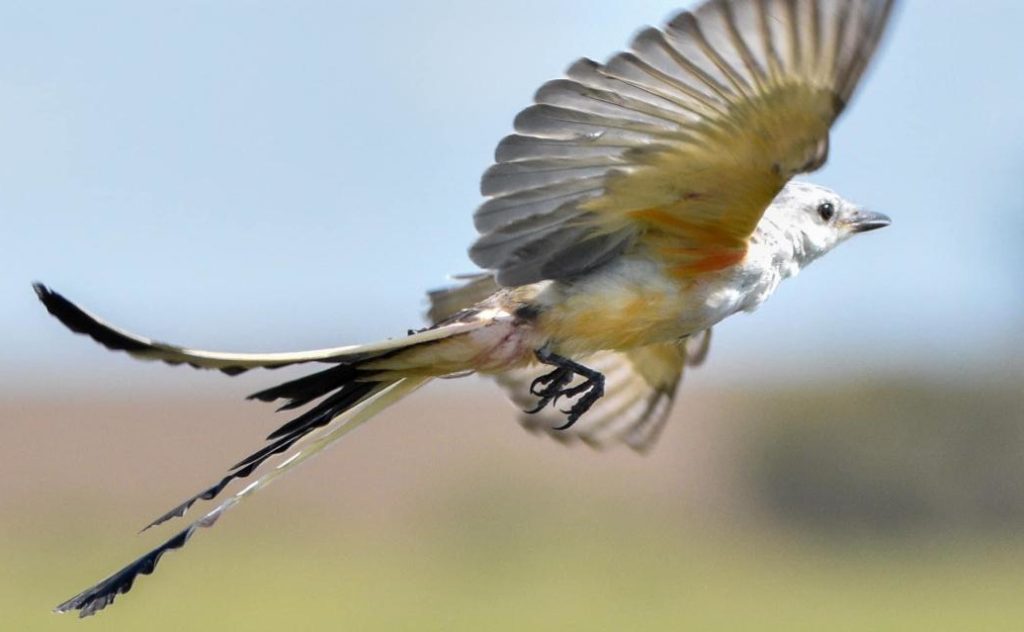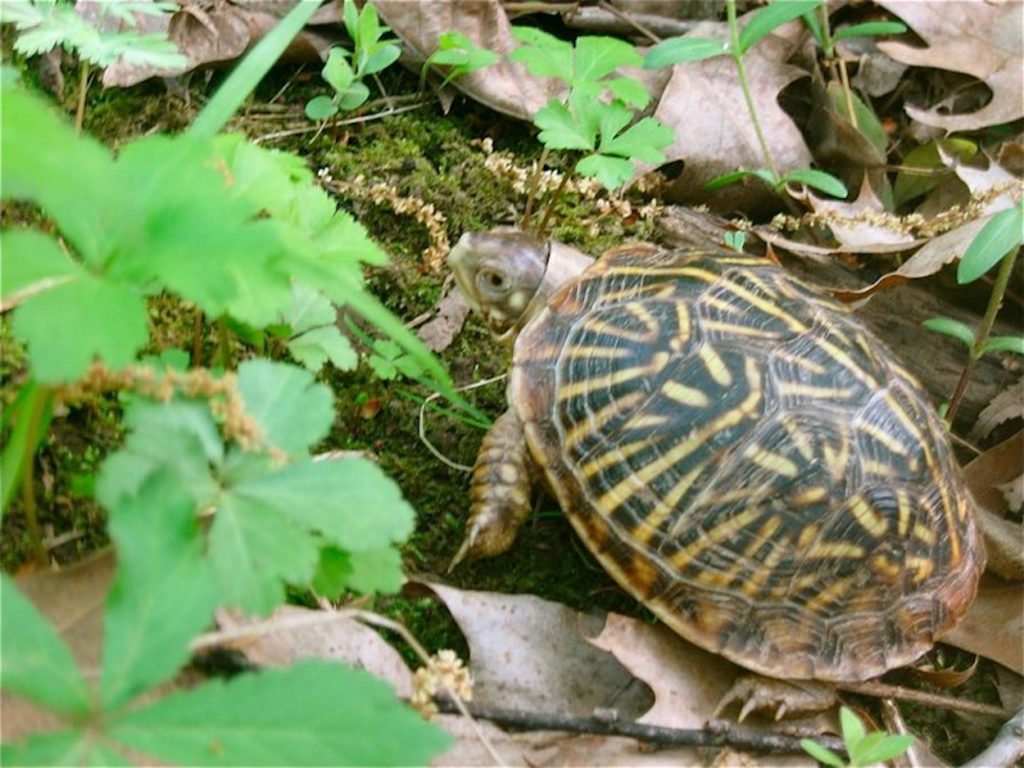About
Squirrels
Squirrels are a common backyard wild animal – grey squirrels and fox squirrels are native to Kansas, while red squirrels are an eastern species.
We receive many calls about them for various issues – from questions about tiny neonate babies blown from their nests on stormy days to injured adults hit by cars to pests chewing holes in eaves and living in attics.
Newborn squirrels are hairless and about the size of a mouse. Eyes open from 21 to 28 days depending on the subspecies.
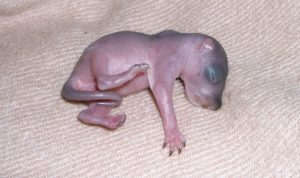
Most people have a difficult time identifying neonate squirrels and might think they’ve found a baby mouse. A squirrel’s head is about the same size as the body, the hands are quite large, and the tail is very thick compared to a mouse, which has a tiny head, hands, and tail. Also, a squirrel’s muzzle is thick, not tapered like that of a mouse.
In years with mild winters, squirrels are born as early as the last weeks of February. Females have one litter their first season and two each season thereafter. The second round can arrive as late as the last week of November.
The weaning process begins at eight to 10 weeks and squirrels are independent at 16 to 18 weeks.

Offspring of late litters sometimes stay with their mother until the following spring. Grey squirrel females may live with their mothers their entire lives in an extended family, raising their babies alongside their mother’s subsequent offspring.
Baby squirrel – To rescue or not to rescue
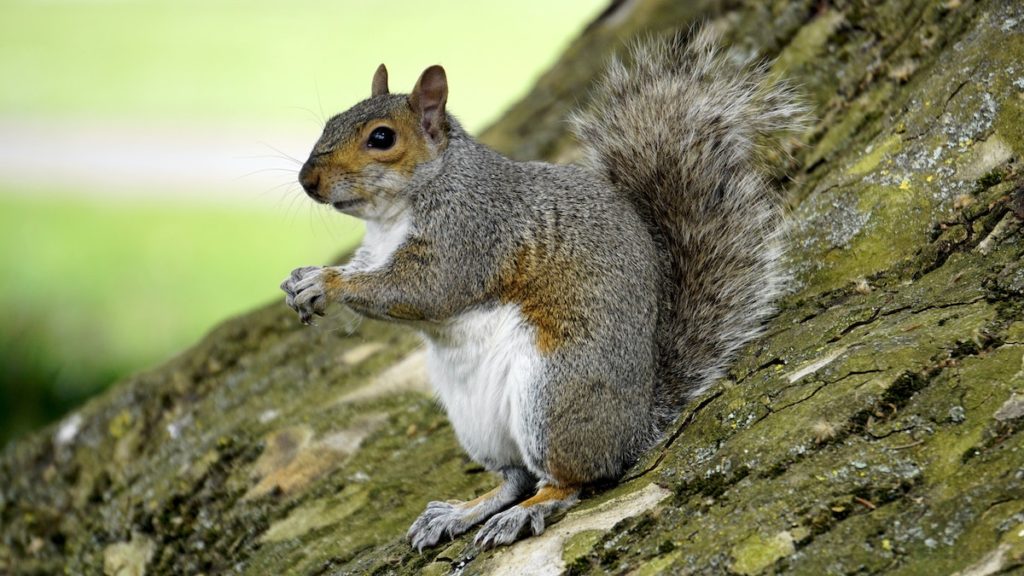
Fell from Nest, Nest Destroyed, Tree Trimmed
Squirrels are very good mothers, and mom should retrieve the baby, even if she detects human scent. Mother squirrels make extra nests as a backup if the nursery nest becomes overcrowded, damaged, or infested with parasites. Just because one nest has been destroyed doesn’t mean that they don’t have a home. Give mom an opportunity to relocate her young. If the babies did not get injured from the fall (no bruises/scrapes/cuts/head injury), the mother should retrieve them.
Mother should return, retrieve babies one by one, and move to alternate nest site. Occasionally, mom will leave only one baby. This is probably done because she’s exhausted and can’t count.
- Step One: Warm the Baby
Hot Hands: these hold heat for up to 8 hours and are the best alternate heat source to use when trying to reunite.
Ziploc bag: Fill a Ziploc bag with warm (not hot) water, put it inside another Ziploc bag – the double bag guards against leaks and prevents the animal from getting wet and chilled. Cover the bag with a small non-terrycloth towel, fleece cloth, or t-shirt and place the baby on it.
Rice bag: You can also fill a sock or knee-high pantyhose with uncooked dry rice. Microwave the rice-filled sock for 30 to 60 seconds. This heat source will last about 20 to 30 minutes. Place the rice sock in the container under the towel, and place the animal on or near it, but not directly in contact with the rice sock.
- Step Two: Wait for Mom
1) If it is not raining or snowing, after the baby is warmed, place the squirrel in a shoe box with a soft rag at the bottom. Do not put the lid on the shoe box. If the temperature is cool or if the baby is hairless, you will need to put the Ziploc/rice bag with it. Important: Do not put baby in a deep box or container. Mom will perceive this as a trap and will not retrieve the babies. Please email a picture of the baby so I can get an idea of what its overall physical state is.
2) Tie, staple or nail the shoebox up in the tree as high as you can get it.
Mom is more likely to reclaim a baby off the side of the tree instead of on the ground. She runs up and down the tree in a circular motion, so she’ll come across it. This also keeps cats and dogs away from them.
3) If you have a smart phone – google “squirrel distress call” and play it. This activates mom’s rooting instinct and she’ll try to locate the source of the sound. If it’s safe for you to put your phone near the box and play the call – this link runs in a loop for 1 hour.
https://www.youtube.com/watch?v=tgXnLN9w5BA
- Step Three: Warm, Dark, and Quiet if babies are unclaimed by dark
Heating Pad: If you have a heating pad, set to low and place the box half on/off the pad, so baby can move away from the heat if needed. Squirrels go to sleep at night, so the babies need to be brought in at dark and hydrated following the directions from the link below or use unflavored Pedialyte. Try again at first light.
https://owl-online.org/its-after-hours-how-do-i-care-for-an-animal/
Repeat Step One at dawn the next day.
If they haven’t been reclaimed by noon – call us 785-542-3625 and we’ll get you in.
Important: If the winds are blowing hard, tree trimmers are still in the area, kids or pets outside mom will stay somewhere safe. She understands that we are predators and will not go near her babies until it’s quiet. Remove pets, kids and allow the tree trimmers to leave prior to attempting a reunite. For trees that are cut down completely – put the box on the stump. The mom will often come back to the location the tree was at.
Here is a link for more information on squirrels. https://owl-online.org/animal-guide/squirrel/
Each baby squirrel costs OWL $ 125 each to raise (that’s just the food – we keep them for 20 weeks) – we want to give mom the best chance to retrieve her young – it’s the best outcome for them and us. If you do end up bringing them in – please consider donating to help with their care. Our finances are finite, and we don’t get outside funding from the government – just the people that bring the animals to us.
Tree Trimming: Until tree trimming is done and everyone has left, keep the babies safely inside. Follow the same instructions as above in Warm, Dark, and Quiet. If the mother hasn’t retrieved the baby in 24 hours she is NOT GOING TOO and you need to contact OWL.
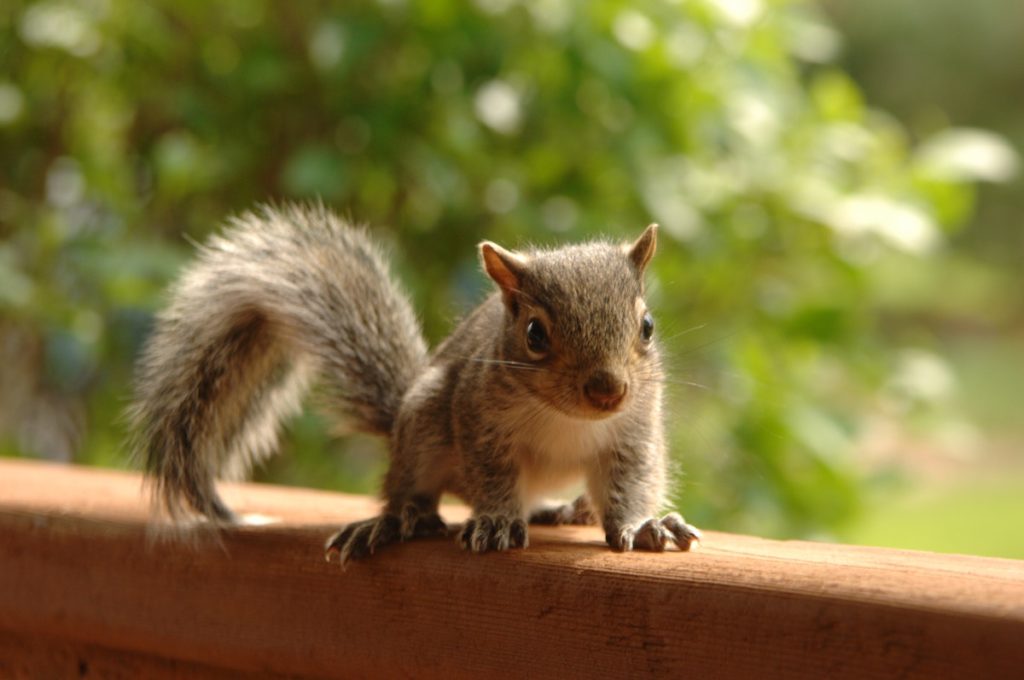
What NOT to DO
- Do NOT Feed
If the baby is hungry it will cry in distress and mom will have a better chance of locating it by the sound. If it has a full belly and is quiet the chances of her retrieving the baby are minimized. Please do not feed the squirrel any formula. It needs 24 hours of re-hydrating fluids before it receives formula. There are various formulas on the Internet, and while some are good, most are not. Licensed rehabilitators know the proper food, amount, and method for feeding baby squirrels. If you feed them incorrectly, fluids can get in their lungs and cause pneumonia, which can be fatal. Most often, it is better to do nothing than to do something incorrectly. The most important thing is to keep the baby warm.
- Do NOT Raise
We often receive baby squirrels that people have tried to raise themselves. They usually have problems such as bloat, diarrhea, hair loss, pneumonia, and metabolic bone disease. They also have been habituated to humans, which means release back into the wild is difficult or impossible. We never raise a baby animal by itself – squirrels (and other babies) are always properly socialized with their own kind.
Caught by Pets
Cats
Cats have mouths full of bacteria that will kill a squirrel in a short time. All wild animals caught by a cat need to be brought in for medication and rehabilitation, even if you can’t see wounds.
Dogs
If a dog brings you an animal bring it in immediately. Dogs have powerful jaws that can create crushing injuries.
Signs of Injuries
If you notice any of these issues, contact OWL as soon as possible:
If an independent squirrel is easily captured, it’s usually a sign that it needs attention. Adult squirrels are very dangerous even when severely injured. They have large teeth, and if they bite you, they’ll leave deep puncture wounds. Any injured adult squirrel should be treated with the utmost respect.
- Has been in cat’s or dog’s mouth, even if there are no visible wounds.
- Broken limb.
- Cuts/scrapes/bruises.
- Cold and lethargic.
- Difficulty breathing, gasping, gurgling.
- Coat matted, patchy.
- Head tilt.
- Odd behavior, such as circling or falling over.
- It is lying on the ground injured or otherwise unable to run away.
A baby squirrel should not be on the ground until it has a big bushy tail just like its parent. If you find one without a big bushy tail, it needs help. In the following cases, the baby squirrel needs to be taken to OWL:
- It runs up to you in the yard or runs up your pants.
- It is emitting a high-pitched squeaking distress call.
- It has been caught by a cat or dog (even if there are no visible wounds).
- It is lying on the ground injured or otherwise unable to run away.
- It is covered with fleas, flies, or fly eggs.
- If you find a baby squirrel and none of the above scenarios apply, it may have just fallen from its nest. Squirrels are very good mothers and should retrieve the baby even if human scent is on the baby.
Please do not feed the squirrel any formula. It needs 24 hours of rehydrating fluids before you feed it. There are various formulas on the Internet, and while some are good, most are not. Licensed rehabilitators know the proper food, the proper amount, and the proper way to feed baby squirrels. If you feed them incorrectly, fluids can get in their lungs and cause pneumonia
Signs of a True Orphan
- Tiny and hairless.
- No adult near or adult squirrel found dead in area.
- Cold and lethargic.
- Covered with parasites, such as fleas or flies or fly eggs (resembles tiny grains of rice in clusters).
- High-pitched squeaking distress call
- Runs up to you in the yard or runs up your pant leg. This indicates desperation for food.
Common Concerns
Any squirrel caught by a dog or cat needs to be brought into us. Squirrels caught by cats need special attention. Cats have mouths full of bacteria that will kill a small animal in a short time. All squirrels caught by a cat need to be brought in for medication and rehabilitation, even if you can’t see wounds.
Mange in outdoor wild animals is not an uncommon problem. Animals have patches of no fur over the back of their head, shoulders and back with minor cases and for serious cases you will see the animal become debilitated and unable to fend for itself. The treatment is fairly easy but caution needs to be taken to not overdose the animal or surrounding animals. Outdoor squirrels can be dosed with a piece of walnut meat and a very small amount of Ivermectin paste horse dewormer. The Paste for horses is actually much safer to use on squirrels than the injectable method of Ivermectin. When treating outdoor squirrels you must be very observant of the squirrel you are treating. Put a very small amount of the paste (about the size of a very small pea, and I mean very small) on a piece of walnut meat will most likely do the trick if the squirrel eats it. Re-treat in 10 days if possible but many times the initial dose is enough. If the animal is already debilitated and not mobile it will need to be captured and brought to OWL. If the squirrel can be treated correctly while living outside than that is the best situation for all. Ivermectin Equine Paste is available at most feed stores and Tractor Supply Stores.
The First Treatment for Shock or Injury: Warm, Dark, and Quiet
If you need to bring an animal into OWL, the most important thing you must do is to keep them warm and quiet.
Container
Put in a shoebox or other container with several small air holes in the lid and a non-terrycloth towel, fleece cloth, or t-shirt in the bottom. Tape the lid to keep secure.
Adult animals should be contained in a dog or cat kennel.
Heating Pad
If you have a heating pad, set to low and place the box half on/off the pad, so the animal can move away from the heat if needed. OR
Rice Bag
Fill a sock or knee-high pantyhose with uncooked dry rice. Microwave the rice-filled sock for 30 to 60 seconds. This heat source will last about 20 to 30 minutes. Place the rice sock in the container under the towel, and place the animal on or near it, but not directly in contact with the rice sock. OR
Ziploc bag
Fill a Ziploc bag with warm (not hot) water, put it inside another Ziploc bag, and place under the towel next to the animal. The double bag guards against leaks and prevents the animal from getting wet and chilled.
Food/Water
Do not attempt to feed or give anything to drink. The wrong foods can quickly cause enteritis (diarrhea) and death. Keeping the animal warm is more important than feeding it.
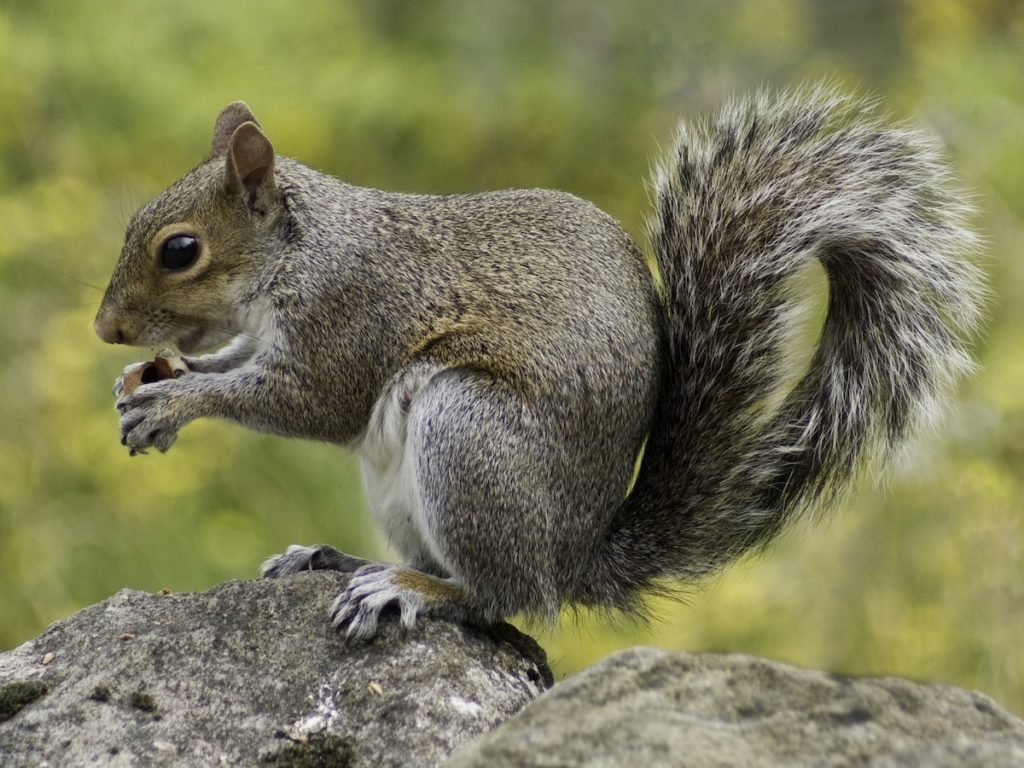
Contact Operation WildLife for help.

